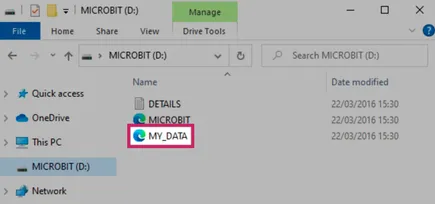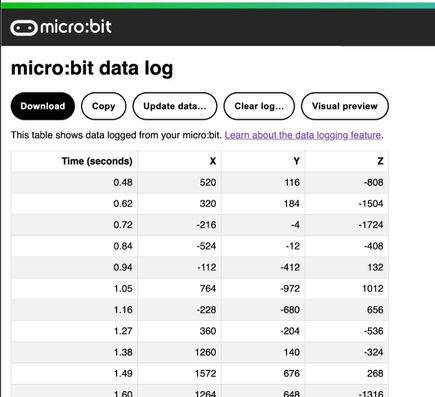Data Logging V2
This module lets you log data to a MY_DATA file saved on a micro:bit
V2 MICROBIT USB drive.

The data is structured in a table format and it can be viewed and plotted with a browser.

Further guidance on this feature can be found on the data logging page of the microbit.org website.
Functions
- log.set_labels(*labels, timestamp=log.SECONDS)
Set up the log file header.
This function accepts any number of positional arguments, each creates a column header, e.g.
log.set_labels("X", "Y", "Z").Ideally this function should be called a single time, before any data is logged, to configure the data table header once.
If a log file already exists when the programme starts, or if this function is called multiple times, it will check the labels already defined in the log file. If this function call contains any new labels not already present, it will generate a new header row with the additional columns.
By default the first column contains a time stamp for each row. The time unit can be selected via the
timestampargument, e.g.log.set_labels("temp", timestamp=log.MINUTES)- Parameters:
*labels – Any number of positional arguments, each corresponding to an entry in the log header.
timestamp – Select the timestamp unit that will be automatically added as the first column in every row. Timestamp values can be one of
log.MILLISECONDS,log.SECONDS,log.MINUTES,log.HOURS,log.DAYSorNoneto disable the timestamp. The default value islog.SECONDS.
- log.set_mirroring(serial)
Configure mirroring of the data logging activity to the serial output.
Serial mirroring is disabled by default. When enabled, it will print to serial each row logged into the log file.
- Parameters:
serial –
Trueenables mirroring data to the serial output.
- log.delete(full=False)
Delete the contents of the log, including headers.
To add the log headers again the
set_labelsfunction should to be called after this function.There are two erase modes; “full” completely removes the data from the physical storage, and “fast” invalidates the data without removing it.
- Parameters:
full –
Trueselects a “full” erase andFalseselects the “fast” erase method.
- log.add(data_dictionary, /, *, **kwargs)
Add a data row to the log.
There are two ways to log data with this function:
Via keyword arguments, each argument name representing a label.
e.g.
log.add(X=compass.get_x(), Y=compass.get_y())
Via a dictionary, each dictionary key representing a label.
e.g.
log.add({ "X": compass.get_x(), "Y": compass.get_y() })
The keyword argument option can be easier to use, and the dictionary option allows the use of spaces (and other special characters), that could not be used with the keyword arguments.
New labels not previously specified via the
set_labelsfunction, or by a previous call to this function, will trigger a new header entry to be added to the log with the extra labels.Labels previously specified and not present in a call to this function will be skipped with an empty value in the log row.
- Raises:
OSError – When the log is full this function raises an
OSErrorexception with error code 28ENOSPC, which indicates there is no space left in the device.
Examples
A minimal example:
from microbit import *
import log
# Set the timer to log data every 5 seconds
@run_every(s=5)
def log_temp():
log.add(temp=temperature())
while True:
# Needed so that the programme doesn't end
sleep(100)
An example that runs through all of the functions of the log module API:
from microbit import *
import log
# Configure the labels and select a time unit for the timestamp
log.set_labels('temp', 'brightness', timestamp=log.SECONDS)
# Send each data row to the serial output
log.set_mirroring(True)
continue_logging = True
# This decorator schedules this function to run every 10s 50ms
@run_every(s=10, ms=50)
def log_data():
"""Log the temperature and light level, and display an icon."""
global continue_logging
if continue_logging:
display.show(Image.SURPRISED)
try:
log.add(temp=temperature(), brightness=display.read_light_level())
except OSError:
continue_logging = False
display.scroll("Log full")
sleep(500)
while True:
if button_a.is_pressed() and button_b.is_pressed():
display.show(Image.CONFUSED)
# Delete the log file using the "full" options, which takes
# longer but ensures the data is wiped from the device
log.delete(full=True)
continue_logging = True
elif button_a.is_pressed():
display.show(Image.HAPPY)
# Log only the light level, the temp entry will be empty. If the log
# is full this will throw an exception and the programme will stop
log.add({
"brightness": display.read_light_level()
})
else:
display.show(Image.ASLEEP)
sleep(500)